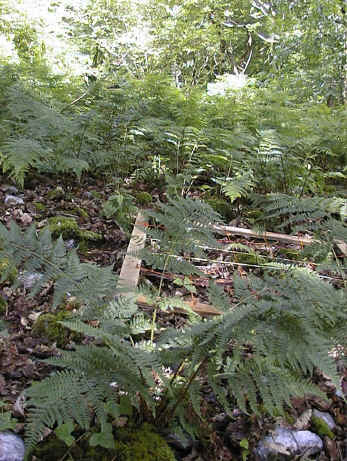Species List of Wet Woodland
Plant Survey - Summer 2001
About the Species List

|
The following observations result from an inspection of the plant species list of the Wet Woodland. There are 70 recorded plant species present across the Wet Woodland Area. Of these, 14 species are mosses, representing 20% of the total. This is a significant amount indicating that mosses are an important component of ground vegetation within the Wet Woodland. Some of the mosses are widespread across the Wet Woodland indicating they are tolerant of a variety of conditions including level of moisture. Some of these mosses are Polytrichum formosum, Leucobryum glaucum, Mnium hornum, Thuidium tamariscinum, Hypnum cupressiforme and Hypnum andoi. Other moss species were confined to certain areas indicating they can only grow where the conditions are favourable. These included:- Eurhynchium praelongum -
found only in the Cherry Area. Tall trees were widespread across the Wet Woodland. Silver Birch was the most common species and occurred in all six areas, while Holly was also present in all six areas but only as very young trees. There were no tall Holly trees in the Wet Woodland. Both Oak and Rowan were fairly widespread while Hazel was specific to the Bluebell Area. Two other species, Red Oak and Oregon Ash were scattered sparsely across a few areas of the Wet Woodland. Non- native cherries occurred largely in the Southwest of the Wet Woodland adjacent to the Heathland. They were found elsewhere in the Wet Woodland in smaller numbers. Ferns were important across the Wet Woodland with Hard Fern and Broad Buckler Fern being widespread. Bramble was also widespread, while certain areas of the Wet Woodland contained species specific to certain conditions. The Bluebell Area supported some shade tolerant plants such as Enchanter's Nightshade, Wood Sorrel and Common Dog Violet, while the Seepage and adjacent parts of the Clearing supported plants which were largely confined to damp conditions, including Wavy Bittercress and many sedges and rushes. Indeed, Star Sedge is found nowhere else at the Woodland Education Centre. Pill Sedge was the exception for the sedges, being tolerant of drier conditions it was found on the Mound and in the Stony Area. The presence of two species of heathers provided evidence that the Wet Woodland was probably at one time lowland heath. Ling was found in the drier areas of the Wet Woodland while the moisture-loving Cross-leaved Heath was found in the Seepage. The Stony Area is quite dry and has many species which also occur in the Heathland that lies adjacent to it. |
Skip Species Lists & Continue to Survey Data